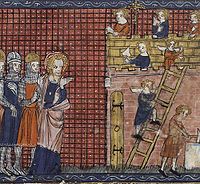Saint Valentine
Saint Valentine is the name of many martyred saints that lived in Ancient Rome. At least three different people named Valentine are said to have died on the 14th of February.[2] Even though nobody knows who exactly Valentine was and where he came from, it has been confirmed that he existed because archaeologists discovered a church dedicated to Valentine.[3]
Saint Valentine | |
|---|---|
 Depicts Saint Valentine and his disciples | |
| Died | c. 269[1] |
| Venerated in | Roman Catholic Church Eastern Orthodox Church Anglican Communion Lutheran Church |
| Feast | February 14 (Roman Catholic Church) July 30 (Eastern Orthodox Church) |
| Attributes | birds; roses; bishop with a crippled or epileptic child at his feet; bishop with a rooster nearby; bishop refusing to adore an idol; bishop being beheaded; priest bearing a sword; priest holding a sun; priest giving sight to a blind girl[1] |
| Patronage | affianced couples, against fainting, bee keepers, happy marriages, love, plague, epileptics[1] |
In the Catholic church, Valentine was the patron of love, young people, and happy marriages.
Valentine's Day
changeThere are many guesses about how Valentine's Day, a celebration of love, started. One legend says that Valentine, being a priest, performed secret wedding ceremonies when they were outlawed by Emperor Claudius II. When someone discovered that Valentine was breaking the law, he was ordered to be executed.[4]
Another theory is that Valentine helped captive Christians to break out of prison. When he himself was in prison, Valentine may have sent the first love letter to a young girl who liked to visit him.[4]
References
change- ↑ 1.0 1.1 1.2 Jones, Terry, Saint Valentine of Rome, retrieved 21 January 2010
- ↑ Knight, Kevin (2009), "Catholic Encyclopedia: St. Valentine", New Advent, retrieved 21 January 2010
- ↑ "St. Valentine - Saints & Angles", Catholic Online, 2010, retrieved 21 January 2010
- ↑ 4.0 4.1 "The History of Valentine's Day", History.com, A&E Television Networks, 2010, retrieved 22 January 2010